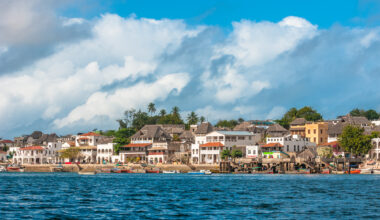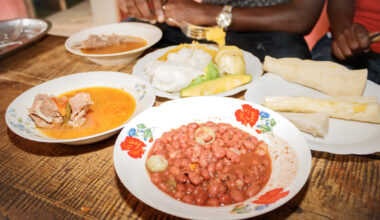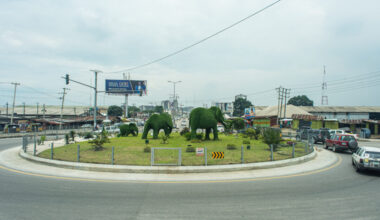By Robert Waldvogel
As a four-decade Certified Travel Agent, international airline employee, researcher, writer, teacher, and photographer, travel, whether for pleasure or business purposes, has always been a significant and an integral part of my life. Some 400 trips to every portion of the globe, utilizing road, rail, sea, and air, entailed destinations both mundane and exotic. This article focuses on those in Africa.
Egypt
The land of the Nile and the pyramids came alive during a flawlessly blue trip one December.
Cairo-accessed sights, almost without saying, included those very pyramids, whose construction commenced in 2550 B. C. as a result of Pharaoh Khufu’s order and which were negotiated by camel. Towering some 481 feet, the Great Pyramid of Giza, the largest, consists of some 2.3 million stone blocks, each weighing 2.5 to 15 tons and is considered the oldest of the Seven Wonders of the Ancient World and the only one to remain largely intact.
Khufu’s son, Pharaoh Khafre, built the second pyramid in 2520 B.C. and it is part of a complex that includes the Sphinx, a mysterious limestone monument with the body of a lion and a pharaoh’s head, which itself may stand sentinel for the pharaoh’s entire expanse of tombs.
The third such pyramid-shaped structure, which is considerably smaller than the first two, was built by Pharaoh Menkaure in 2490 B.C. and features a much more complex mortuary temple.
Additional attractions included the temple of the Great God Ptah in Memphis, a 5,000-year-old symmetrical, alabaster sphinx, and the original statue of Ramses II. The Necropolis in Sakkara afforded an opportunity to inspect its tombs and its own step pyramid.
The immersion into Egyptology was capped with a visit to the Papyrus and Egyptian museums, the latter built by the Italian construction company Garozzo-Zaffarani and constituting one of the largest such repositories with 120,000 items, not all of which were on display at a single time. But some of its most significant was Tutankhamun’s Mask, the Grave Mask of king Amenemope, the Narmer Palette, the Mummy Mask of Psusennes I, the Statue of Khufu, the Statue of Khafra, the Statue of Menkaure, and the Merneptah Stele.
Morocco
Two multi-mode trips to Arabic- and French-speaking Morocco facilitated considerable country coverage.
Significant Casablanca sights included its Medina, the Royal Palace, the Hassan II Mosque, the world’s second-largest after that in Mecca, Mohammed V Square, and a Moroccan handicrafts store.
A drive to Rabat encompassed its own Royal Palace, the Mausoleum of Mohammed V, the Hassan Tower, and the Kasbah of Oudaya, evoking images of the Humphrey Boggart movie, Casablanca.
Morocco’s famous and wonderful couscous, sometimes enjoyed with live entertainment, was consumed in numerous restaurants. Lunch in the Golden Tulip Rabat, for instance, featured eggplant salad; olive chicken, couscous, and carrots; and thin chocolate pastries and custard-flan with fruit. A later sip of Moroccan mint tea in Rick’s Café in the Kasbah of Oudaya really generated movie memories. Its French influence was expressed in its crispy baguettes.
Marked by Moorish minarets of the 12th-century, Koutoubia Mosque, in Marrakech, was a former imperial city in the western part of the country, but is today characterized by palaces, gardens, and the densely packed, walled medina dating to the Berber Empire. Threading my way through its maze-like alleys, I passed and perused its souks, or marketplaces, which displayed some items like textiles, pottery, and jewellery.
While a train had linked the city with Casablanca, an internal flight closed the gap between it and Tangier, a port city on the Strait of Gibraltar that has served as a strategic gateway between Africa and Europe since Phoenician times. Its whitewashed hillside medina was home to the Dar el Makhzen, a palace of the sultans that had since been transformed into a museum with a rich collection of Moroccan artifacts.
Tunisia
Although Arabic and French similarly provided the communication lines in Tunisia, my German often substituted in English-deficient areas.
Tunis, located on the Mediterranean Sea and the country’s capital, afforded sightseeing opportunities in its Bardo Museum, Hammamet, and Nabeul.
Carthage, a seaside suburb known for its ancient archaeological sites and founded by the Phoenicians in the first millennium B. C., was originally the seat of the powerful Carthaginian Empire, which fell to Rome in the second century B. C. Today it retains a grip on its history with such remnants as its Amphitheatre, Byrsa Hill and the National Museum of Carthage, the Roman Theatre, the Baths of Antonin, and Sidi Bou Said.
A short, domestic turboprop flight to the island of Djerba varied my view of the country, with a stay in the seaside Hotel Hasdrubal and sightseeing of Guellala and Houmut-Souq. It’s a small, but elegant restaurant dripped of French cuisine and a butter-sautéed filet mignon entrée one evening was memorable.
A standard-shift Fiat rental car facilitated a drive to Medenine and Matmata, a small., Berber-speaking town in southern Tunisia, often on road stretches that hugged mountains and consisted of little more than sand and chopped rock. But they ultimately opened up to the latter’s anticipated, but virtually empty expanse of troglodyte architecture, because that consisted of surface-invisible, subterranean, cave-reminiscent construction to reduce exposure to extremely high temperatures during the day. As the most famous filming location of the Star Wars movie series, Matamata substituted for Tatooine, Luke Skywalker’s birthplace.
A return drive to Jorf completed the circuit to Djerba after a ferry crossing from it and another internal flight led to Tunis.
Cape Verde
Officially designated the Republic of Cabo Verde, Cape Verde is an island country in the Central Atlantic Ocean, its ten volcanic island archipelago having collectively created the 4,033-square-kilometer landmass.
Enticing as a destination that it was, it regrettably only served as an intermediate stop in Ilha do Sal, or Sal Island, during transatlantic flights between New York and Johannesburg.
Democratic Republic of the Congo
Similarly, and sadly, the Democratic Republic of the Congo, historically Zaire and now the largest country in sub-Saharan Africa and the second largest on the continent, was only glimpsed on landing in Brazzaville, its capital, located on the Congo River opposite Kinshasa.
Nevertheless, the dark, predawn landing in Ilha do Sal was replaced by a bright morning one here after a sector from Lisbon that would continue to South Africa, except that the moment the main wheels touched its soil, a band of natives, perhaps ignorant of modern technology, emerged from the bush and stormed the runway.
Zimbabwe
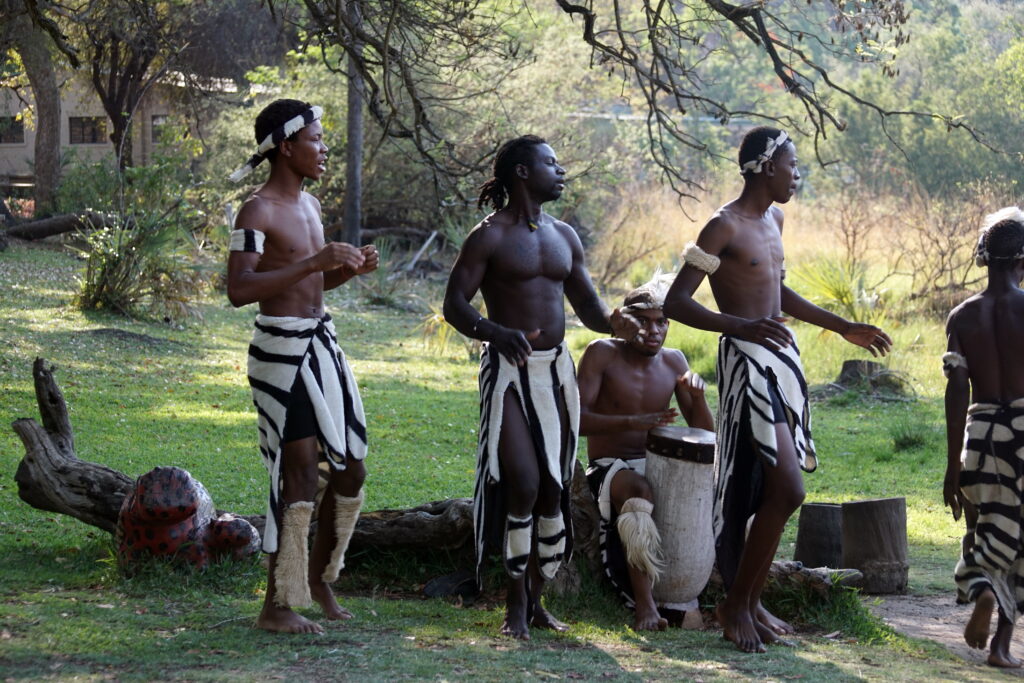
Zimbabwe offered another multiple travel-mode and -aspect African-immersion but provided several unexpected experiences and retrospectively taught just as many lessons. They could be pegged by the locations of the eight hotels.
After an overnight in Johannesburg, South Africa, for instance, a fully booked flight to Harare, the intended destination and gateway to Zimbabwe, caused a rerouting to Bulawayo instead. Although an unreserved rental car was miraculously secured, it’s less than shiny-new condition proved that facilities and standards were not always those expected in the United States.
During a drive to the first destination, Hwange National Park, the travel group took guesses at the distance to it, since it appeared significantly shorter than the 500-kilometre one from Harare, the originally intended starting point. Most said, “It has to be about 100 kilometres.” But a glance at the map’s legend read 1,000 instead. Incredulous, all considered it a mistake. But here again, US standards proved the culprit: while the distance was less than a quarter what it would have been from Harare, the assumption that a road existed to connect the two points was erroneous. The quoted distance was correct because it required following a highway down south before intercepting the northerly one on the other side.
Signs along the road continually pointed to “braais.” This, as was learned, was the Afrikaans word for “barbeque,” which had been adopted into the English language, and its frequent appearance indicated the value locals placed on the activity with family and friends.
Accommodation in Hwange National Park’s Main Camp was in rustic, thatched-roof bungalows. At night, the Southern Cross appeared with crystal clarity, as if it had burned its imprint into a molten sky. Not a rustle could be heard, but at the first light of dawn, the surrounding animals emitted a collective grunt, shrill, and shriek that audibly cracked the silence more than the light visibly cracked the horizon. The day had arrived, and their bodily clocks had been set by the rising run. It was time to eat.
The park’s dirt roads were plied during both self-drive and private game safaris, but the sunrise one in a jeep the following morning was particularly memorable as dawn infused the eastern horizon with a flood of color.
The elegant Victoria Falls Hotel provided a marked contrast to the game reserves at the next destination, and the famed falls, with their luminescent force and audible pound, were enjoyed both in person and from the air during a sightseeing flight. The outdoor “Africa Spectacular” performance, permeating the audience with waves of African rhythm, was a highlight.
While the following night’s Makasa Sun Casino Hotel was only marginally lower in scale than the previous night’s Victoria Falls Hotel had been, it still offered a close-proximity inspection, but the day’s small-boat Zambezi River safari, during which wine and cheese were served, was precarious for the half-dozen European vacationers in the neighboring vessel. The glide over the glass surface and the silent stillness was unexpectedly fractured when their boat mysteriously rose from the river and spilt its inhabitants into the water. Screaming and gasping for air, they latched onto the side of our own and we slowly escorted them back to shore and safety. The culprit, we ascertained, was a hippopotamus that had swam under the boat and then rose, lifting the contents on its back out of the river.
Shopping at the Falls Craft Village re-introduced life’s banality.
An overbooked commercial flight from Victoria Falls to Harare, with an intermediate stop in Kariba the following day, necessitated my relocation from the passenger cabin to the cockpit, but it gave me the opportunity to observe “up-front” procedures, take notes, and ultimately write an article about the experience.
After another single-night stay–this time in the conventional, modern-conforming, almost characterless Sheraton Harare-we were able to intercept our original itinerary. Inspections of the area’s Harare Gardens, African Unity Square, and the Epworth Balancing Rocks offered glimpses into its importance and a memorable dinner later than evening took place in the Ramambo Lodge Restaurant.
A second rental car facilitated travel to the Troutbeck Inn, located at a 6 500-foot elevation in the surrounding mountains and thus inviting exploration of the Nyanga Highlands’ scenic beauty and absorption of its crisp mountain air. Fireplace-provisioned rooms induced deep, peaceful, civilization-separated sleep. Multiple-course, menu-detailed breakfasts and dinners were included.
One breakfast, in the first case, encompassed the traditional Troutbeck buffet with assorted fruit juices, breakfast cereals, fresh and preserved fruits, assorted yoghurts, selected cold meats, selected cheeses, Danish pastries and croissants, homemade butter scones, local preserves, marmalades, and honey. The cooked breakfast portion included fried, poached, boiled, or scrambled eggs, breakfast omelettes, pork or beef sausages, crisp farmhouse bacon, sautéed potatoes and grilled, tomatoes. The day’s Troutbeck breakfast special was fresh minute steak with fried onions.
The dinner menu detailed pate a la maison served with crisp melba toast and Cumberland sauce; cream of celery soup garnished with chopped nuts; poached fillet of Nyanga trout blanc fume coated in a delicate rose wine sauce; entrees of grilled entrecote chasseur with onion, tomato, and mushroom sauce, or roast leg of pork with roast gravy and apple sauce, Savoyarde gratin potatoes, country vegetables in season; Devonshire ice coupe with whisky liqueur and peach salad or lemon cream pudding; a selection of fine Zimbabwe cheeses and biscuits; filter coffee and Tanganda tea.
Morning horseback rides through the forest’s trails brought breathtaking views of Pungwe Drift and Pungwe Falls.
A return home, across the Atlantic, required a retracing of steps-first to Harare for another overnight stay and then to Johannesburg for a day room, before the sixteen-and-a-half-hour flight, via Ilha do Sal in Cape Verde, to New York.
South Africa
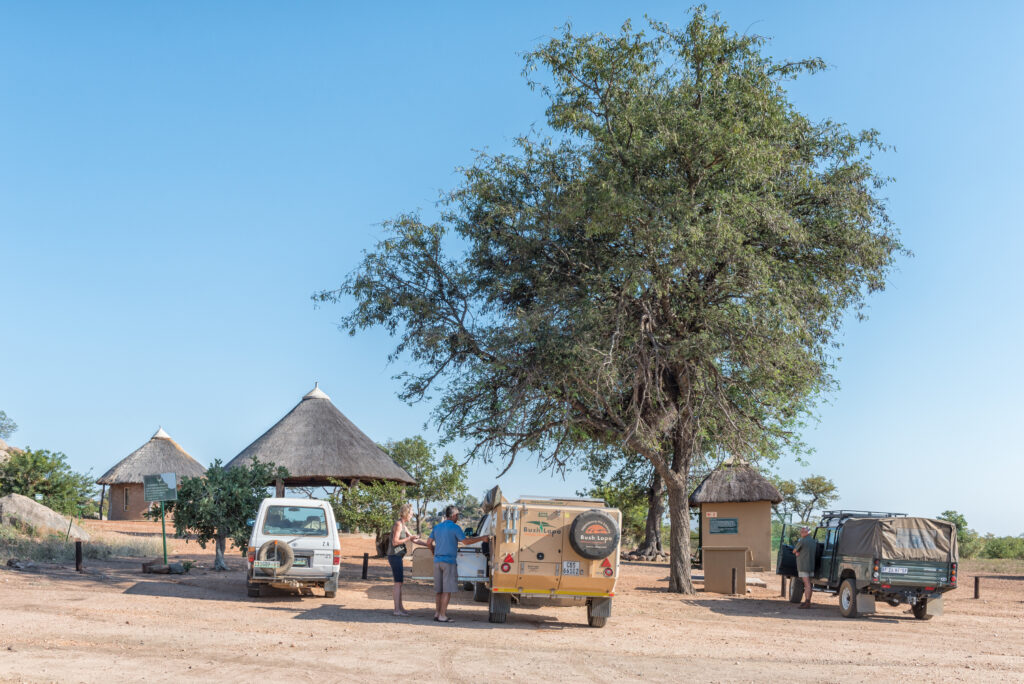
Lile Zimbabwe, South Africa offered an equally varied, all-encompassing, multi-mode travel experience, resulting in significant kilometre coverage and an almost nightly hotel change.
Accessed by Johannesburg, it provided an introduction to its history in Pretoria, one of the country’s three capital cities and the seat of the government’s executive branch. Significant sights here included Church Square, the Kruger House, the National Zoological Gardens, the Union Buildings, and the Voortrekker Monument, the hilltop-located granite structure that commemorates the Voortrekkers themselves, who left the Cape Colony between 1835 and 1854.
Natural, almost other-planetary topographical features characterized the Transvaal Drakensburg, including those of Graskop, God’s Window, the water-eroded, geological Bourke’s Luck Potholes, and Blyde River Canyon.
The Floreat Protea Hotel in Sabie, offering the restorative rest after a day of mileage and a mélange of sights, was described as “Set on the banks of the Sabie River in the beautiful Eastern Transvaal, the Floreat has a special place in this heavenly part of South Africa. With its perfect climate, majestic forests and landscapes, and lush subtropical vegetation, this is the place.”
Kruger National Park, in northeastern South Africa, is one of the continent’s largest game reserves and offered several safari adventures with its particularly high density of “Big Five” animals, including lions, leopards, rhinos, elephants, and buffalos. Laden with cameras and lenses, I frequently preserved pockets of wildlife existence, snapping shots of cheetahs, spotted hyaenas, zebra, giraffes, kudus, impalas, wildebeests, and antelopes.
Nightfall necessitated two in-park stays-one in Skukuza, located at the confluence of the N’waswitshaka and Sabie Rivers in Mpumalanga, and the other in Crocodile Bridge-with outdoor kitchens, but indoor bedrooms in circular, thatched-roof huts. Provisions purchased at the local camp store provided dinner ingredients cooked under the crystal, clear Southern Hemisphere stars, whose majestic infinity sparked a conversation about God and eternity.
As was typical of flat, desert-like terrain, days created swelter, but nights rapidly descended to the freezing level.
A domestic flight from Johannesburg to the port city of Cape Town, located on South Africa’s southwest coast on a peninsula beneath the imposing Table Mountain, became the threshold to a walk along the Alfred and Victoria waterfront, an ascent on the Cableway to the 3,500-foot summit of the mountain itself, a drive in the shadow of the Hottentots Holland Mountains through tree-lined lanes past white gabled Cape Dutch homesteads to the Paarl, Franschhoek, and Stellenbosch wine-making areas for tours through the oak- and grape-scented cellars and subsequent tastings, and a trek to the Cape of Good Hope, a meeting point of the Indian and Atlantic oceans. Described as “the fairest Cape that we saw in the whole circumference of the globe” by Sir Francis Drake, it was the southern-most point on the African continent
The article was first published at Ezine.com and is published here with permission.
https://ezinearticles.com/

